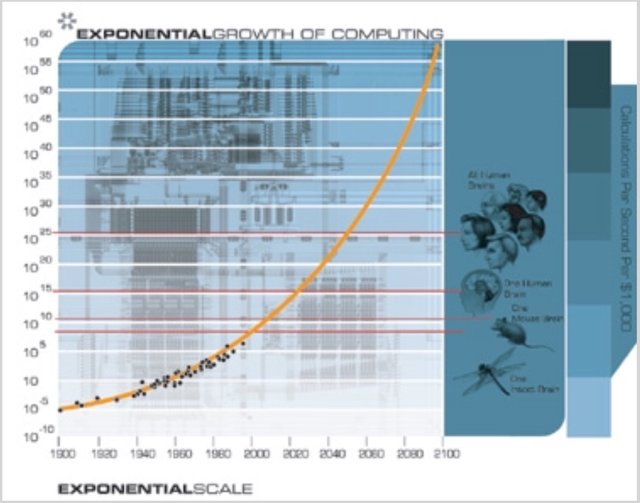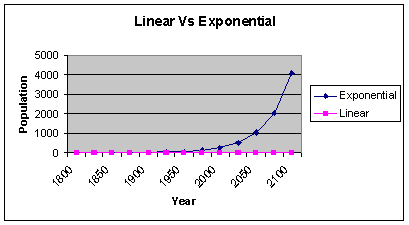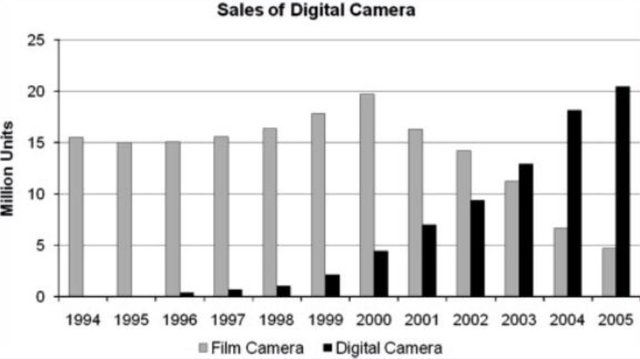
Foresight
The future of humanity is in influenced to a great extent by the interplay of two important factors--human nature and the Law of Accelerating Returns ("LAR"). Because human nature is in the aggregate predictable, and the Law of Accelerating Returns even more so, the astute among us can successfully predict certain global macro trends well in advance.
Human Nature and Herding
Human nature is predictable in the aggregate mostly because the herding instinct is a universally evolved coping mechanism. In the face of uncertainty, humans (and many other species) herd.
Because herding is so common, we can only assume it to be the product of evolution. Herding is evolution's way of guiding individual decision making in the absence of accurate or complete information. When individual actors are not confident that they know more than others, they mindlessly follow the crowd. This is true in day-to-day life, but it is especially true during periods of panic, euphoria or high uncertainty.
Herding is therefore not a sensible, rational, calculated response to a known stimulus, but rather an instinctual and unconscious response to uncertainty.
Why The Herd Moves
In the absence of a perceived information advantage, few individuals will linger for long beyond the margins of a given herd. Those who do are very confident that they know something the herd doesn't. If wrong, they quickly parish or return to the herd. But, if right, they disproportionately prosper.
In the latter case, a few others in the herd soon notice the disproportionate success of the outliers and begin to follow them. They too experience disproportionate success. This pattern repeats over and over until a tipping point is reached and the whole herd seemingly moves as one to follow the trail blazed by the initial outliers. Most Individual in the herd have no idea why or where the herd is migrating, they just follow the crowd to greener pastures.
Viewed from above, the herd's movements appear to be random, first veering one direction and then another. It can seem difficult or impossible to predict the movements of these herds. But...is it? I think not, at least in some instances.
The Law of Accelerating Returns
While humans predictably herd, technology moves even more predictably following Kurzweil's Law of Accelerating Returns ("LAR"). The Law of Accelerating Returns, of which Moore's Law is a subset, describes how all information technologies advance at predictable exponential rates. Because information gained yesterday can be used to gain even more information more cheaply today, technological progress snowballs leading to exponential growth curves and declining costs. We see this everywhere in the information sciences.
For instance, this chart illustrates the number of computations per second per $1,000 spent on computers:

Source: Ray Kurzweil
The chart above stops its plots in the year 2000, but were we to plot data points to the present day, they would, not surprisingly given Moore's Law, fit the yellow prediction line almost perfectly.
Humans are Challenged to Grasp Exponential Growth
It's odd that such predictable growth in technologies consistently surprises so many people, at least until we remember that it's only since the dawn of the Information Age that humans have regularly experienced multiple impactful episodes of exponential growth cycles over the course of a single human lifetime. Consequently, ancient man did not evolve to easily conceptualize or predict the results of exponential growth--there was simply no need.
Said another way, while we can model exponential growth mathematically in spreadsheets, humans consistently fail to account for it in our ordinary, day-to-day mental models of the world. For instance, ask the average person to quickly estimate how many doublings it would take to get from 1% to 100% and he/she will almost invariably overestimate the correct answer (which is only a little over 6).

As the chart above shows, when the time between exponential doublings is long (in relation to a human life span), as they often are in nature, it's easy for humans to mistake exponential growth for simple linear growth, or at least to severely underestimate the future impact of the observed growth. Looking at the above chart, it's not until the "knee of the curve" is reached, or approximately the third doubling from 1 percent (which in this case took centuries) that exponential growth becomes obviously distinguishable to humans from ordinary linear growth.
What We Know and What It Means
At this point we know that humans herd. We also know that herding is not rational but rather instinctual. And finally, we know that humans consistently fail to account for exponential growth in their mental models of the world. Can we use these three points of knowledge to successfully predict the future?
I think we can.
Specifically, we can predict the general direction toward which the herd will move and, maybe more importantly, from which it will move.
How to Predict the Future
The first trick to predicting the future is spotting exponential growth trends as early as possible, especially trends involving information technologies. In today's Information Age, this is not a difficult challenge in most instances.
The second trick is to recognize that exponential trends in information technology are generally antifragile and often benefit from Moore's Law (or the Law of Accelerating Returns) and network effects. This means that we can reliably assume with a high (but less than 100 percent) degree of certainty that any such trend, once sufficiently started, will persist despite the doubters and naysayers and unforeseen obstacles.
This is because antifragile systems are not just robust (in the sense of successfully resisting adverse change), they actually benefit from being stressed---that is, they rapidly evolve to counter or compensate for the effects of the stressor, making the system even more stable and secure and thereby ensuring its continued exponential growth trend.
One example of this is Moore's Law itself. For decades people have been predicting imminent demise of Moore's Law, and yet like clockwork we've consistently adapted new ways of fitting ever more transistors on a given-sized chip for the same or lower cost. Will this trend end eventually? Almost certainly. But only after nearly a century of defying predictions to the contrary and probably only after something much better comes along to replace it (like 3D computing and/or quantum computing).
Why are technological trends so antifragile? Economies of scale, network effects, ever-increasing quality and rapidly declining costs all conspire to preserve the trend until either a saturation point is reached or something at least ten times better comes along (this is often known as the "10X Principle").
In short, once we spot a technological trend early and recognize that it will likely persist in antifragile ways, predicting the future is easy. Or...at least it should be.
A Simple Example
Consider the example of digital photography versus film photography:

Armed with superior knowledge, a few adventurous members of the human herd began in the mid-1990s to favor digital cameras over film ones, and they experienced better outcomes, at least for some limited use cases. Over time, other members of the herd increasingly noticed the success of these digital outliers and began moving in that direction as well.
By 2000, a tipping point was reached: Due to Moore's Law and related technological maxims, digital camera quality was finally just "good enough" to disrupt the growth trajectory of film cameras, making the success of the digital outliers obvious to a larger percentage of the herd. Consequently, many turned that direction, drawing the attention of yet more members. Over the next fifteen years, nearly the entire herd would "go digital" en masse, decimating the sales of film cameras.
The Lesson
While the demise of film and the advent of digital seems like a forgone conclusion in hindsight, it came as a complete shock to the mainstream herd, including the film photography industry itself. During the middle to late 1990s (when the exponential growth curve of digital cameras was just becoming noticeable), film photography manufacturers remained surprisingly complacent.
One reason for their complacency is the previously-noted difficulty to mentally model exponential growth. Exponential growth often becomes evident to humans only once the "knee of the curve" is reached. Consequently, the threat to the film industry wasn't perfectly obvious to all but the most prescient until disaster was both imminent and unstoppable.
Another reason for film industry complacency was that the new digital cameras were initially fairly expensive and offered very poor image quality. Though Moore's law and related axioms would quickly close the gap, this fact was, once again, unnoticed to all but the most prescient before it was too late.
Complicating matters more, sales of film cameras continued to rise throughout the late 1990s (along with the exponentially increasing sales of digital cameras), giving legacy film manufacturers reason to believe that the two technologies could prosper side-by-side. Even if digital cameras continued their exponential growth, they wouldn't materially impact the sales of film cameras, right?
Even so, by simply spotting the exponential technological trend early and recognizing their likelihood of persisting, astute observers could have predicted the herd's ultimate move en masse toward digital photography, and they could even have gotten the timing of the mass migration almost exactly right. Furthermore, while it might have been difficult to predict which particular digital camera manufacturer (if any) would come to dominate the nascent digital photography industry, it was trivial for astute observers to predict which companies would ultimately be decimated by the change (e.g., Kodak).
Conclusion
Once we recognize the human tendency to herd and antifragile nature of many of today's innovative technologies, the future can be foretold with heretofore unknown degrees of accuracy. For instance, while it may be difficult to predict which particular blockchain or blockchain company will come to dominate, it's trivial to predict (from current growth trends) that blockchain technology will disintermediate almost everything, and which companies and institutions will be decimated as a result.
This insight into the future gives us confidence to embrace it with arms wide open.

*Arms Wide Open*
Photo credits: Me
Photo subject: @steemed-open
“The greatest shortcoming of the human race is our inability to understand the exponential function.” ― Albert A. Bartlett
Downvoting a post can decrease pending rewards and make it less visible. Common reasons:
Submit
Oh that's awesome. I'd never heard that quote before or I would have used it!
Downvoting a post can decrease pending rewards and make it less visible. Common reasons:
Submit
Nice article. I think within our lifetime though, Moore's law will turn into an S curve. If you extrapolate 10-20 years beyond 2100 in the first graph, $1000 will buy you more computations than atoms in the known universe, 10^78 to 10^82 atoms. Not saying that's impossible, but I'll believe it when I see it.
Downvoting a post can decrease pending rewards and make it less visible. Common reasons:
Submit
Excellent artticle,really spot on.It´s interesting that there are many trends growing exponentially that are quite unknown to thepublic.One example is localised digital manufacturing initiatives like the fab lab http://fabfoundation.org/fab-labs/what-is-a-fab-lab/ and microelectromechanical systems(MEMS) https://en.wikipedia.org/wiki/Microelectromechanical_systems
You are upvoted and followed!
Downvoting a post can decrease pending rewards and make it less visible. Common reasons:
Submit
I could read stuff like this all day. I want more stuff like this to read. Much appreciated. You are so being followed now.
Downvoting a post can decrease pending rewards and make it less visible. Common reasons:
Submit
As I read I could only think of Psychohistory and Isaac Asimov - predicting the future of "the masses" being easier the bigger the herd gets. Of course it's sci-fi but whether you're talking politics or economics, it seems predicting the future is less fiction and more reality. Hopefully this serves a beneficial purpose for humanity and not pump-and-dump moneygrabs ;)
Vincent
Downvoting a post can decrease pending rewards and make it less visible. Common reasons:
Submit
I usually follow the herd for trading crypto with a few exceptions from time to time. Herds are usually pretty truthful, unless they are dead wrong. It appears herds are very resilient, until a large group attempts herd manipulation. Look what happened when Etherum tried to Fork the herd, and ETC sprung up! The herd is dynamic, and will self correct!
Downvoting a post can decrease pending rewards and make it less visible. Common reasons:
Submit
I like your example of digital photography. Another great example is what happened with Blockbuster and Netflix. Use cases for which industries will be disrupted by blockchain is well documented. How companies in those industries respond has yet to be determined. I work in financial markets and financial services which is primed for major disruption.
Downvoting a post can decrease pending rewards and make it less visible. Common reasons:
Submit
In 10 years the the legacy banking industry will look the same as film to digital cameras. Some banks will evolve into "Blockchain Apps" but most will fail. In blockchain there's no middle man and no need for "trusted 3rd party institutions such as banks. This will be interesting :-)
Downvoting a post can decrease pending rewards and make it less visible. Common reasons:
Submit
I believe the big banks will adapt and survive. Most of the near term benefits speak to cost reduction for firms. One big winner in this space will be the firm that can attract and retain the 2 billion unbanked looking to use crypto for daily expenditures.
Downvoting a post can decrease pending rewards and make it less visible. Common reasons:
Submit
I agree in the short term but long term the barriers to entry are likely to drop down significantly and allow smaller more flexible Fintech companies to come in.
Downvoting a post can decrease pending rewards and make it less visible. Common reasons:
Submit
Downvoting a post can decrease pending rewards and make it less visible. Common reasons:
Submit
Very interesting post! Thank you for taking the time to put it together and share it with the steemit community.
Steem on,
Mike
Downvoting a post can decrease pending rewards and make it less visible. Common reasons:
Submit
@etcmike, your generic response to people's posts might get some people to think you are a bot and downvote you... I'm always worried about real people getting downvoted or flagged. Anyways, @sean-king pretty lady + deep thinking = rising to the top, so have fun.
Downvoting a post can decrease pending rewards and make it less visible. Common reasons:
Submit
Very interesting. I've suspected this but great to see it in such great context! UpVoted!
Downvoting a post can decrease pending rewards and make it less visible. Common reasons:
Submit
Your takes from a more evolutionary perspective really intrigue me. You have a different slant on things than I typically find from anarchic minds. @sterlinluxan recommended a book to help better understand his perspective and I was wondering if you had a flagship book on your shelf that you'd also recommend for me to check out. I'm trying to fill up my cart before ordering. Thanks in advance! :)
Downvoting a post can decrease pending rewards and make it less visible. Common reasons:
Submit
Thanks so much for the kind feedback.
I love books and could recommend dozens, but I'll limit my recommendations to five of the ones that have influenced my thinking most:
The Singularity is Near
The Black Swan
Sex at Dawn
Why Beautiful People Have More Daughters
The Zero Marginal Cost Society
The first two and the last one are pretty dense reading, requiring focus to follow. The middle two are easy reads.
Hope you enjoy them, and thanks again!
Downvoting a post can decrease pending rewards and make it less visible. Common reasons:
Submit
Added them all to my list. I've had Black Swan on my mind for a while, as I like Nassim a lot. I think I haven't gotten it yet because of its dense nature, as you mentioned. But, hey, I figure if I can get through Mises and Rothbard, I can get through some other dense stuff as well. This is a nice little push that I needed to get into some new and different books. Thank you!
Downvoting a post can decrease pending rewards and make it less visible. Common reasons:
Submit
Hope you enjoy. Taleb's book Antifragile is one for the ages also.
Downvoting a post can decrease pending rewards and make it less visible. Common reasons:
Submit
Good stuff. Got to keep up with the herd ways of our species to better figure what direction we are heading in. Just got to thinking recently I can be a referee in the game of life cause life is not a game. If we understand our nature we can better predict future behavior .
Downvoting a post can decrease pending rewards and make it less visible. Common reasons:
Submit
Very interesting. I think the next crypto currency to make moves will be Zcash. People have been working on it for a long time and it seams to have more of an original satoshi esque vision to it.
Ofcourse steemit will grow in strides due to this excellent combo of SEO and incentiviced jackpot system to keep great content coming and new writers signing up.
Downvoting a post can decrease pending rewards and make it less visible. Common reasons:
Submit
It is what it is. People often refuse to think for themselves and act - like everyone else. And at the same time, did not think about the consequences.
Downvoting a post can decrease pending rewards and make it less visible. Common reasons:
Submit
I believe Bitcoin will evolve into a currency used for longterm store of value. People will park Trillions of dollars into Bitcoin one day. Steem is interesting but I wouldn't dump to much capital into such a new technology just yet.
Downvoting a post can decrease pending rewards and make it less visible. Common reasons:
Submit
Keep these good posts coming! I did not know when I joined steemit there would be so much quality information here!
Downvoting a post can decrease pending rewards and make it less visible. Common reasons:
Submit
Breathtaking scenery!! Where is it ??
Downvoting a post can decrease pending rewards and make it less visible. Common reasons:
Submit
Yes, it was amazing. It's near Tortilla Flat, Arizona.
Downvoting a post can decrease pending rewards and make it less visible. Common reasons:
Submit
Very strong and interesting post....I like it :) it is indeed a pleasure to read.
Thank you!!
Downvoting a post can decrease pending rewards and make it less visible. Common reasons:
Submit
Downvoting a post can decrease pending rewards and make it less visible. Common reasons:
Submit
Best way to predict the future is based on past data. Time moves in cycles.
Downvoting a post can decrease pending rewards and make it less visible. Common reasons:
Submit
I am currently invested in this crypto. I think the prediction markets have a lot of potential.
https://steemit.com/augur/@ilovesteemit/how-the-future-will-be-predicted-online-gambling-will-be-uncontrollable
Downvoting a post can decrease pending rewards and make it less visible. Common reasons:
Submit